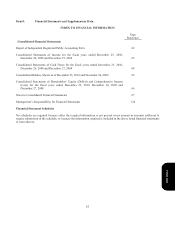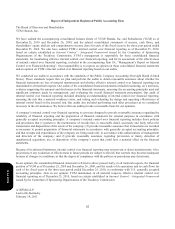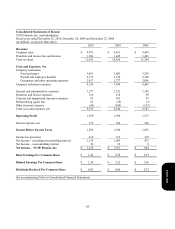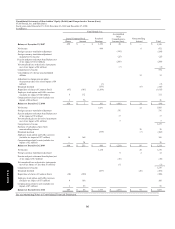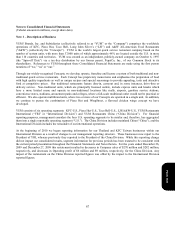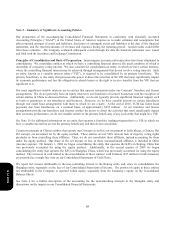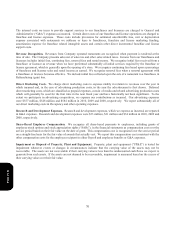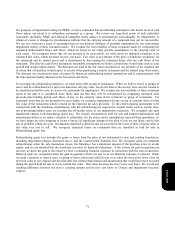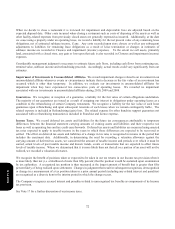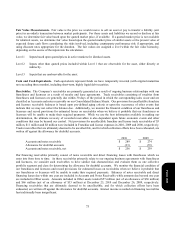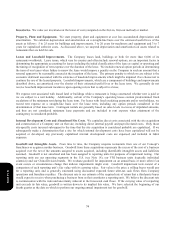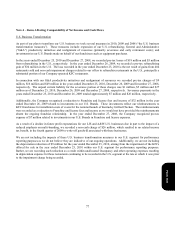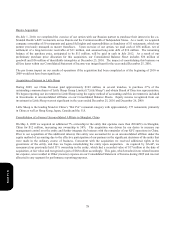Pizza Hut 2010 Annual Report Download - page 165
Download and view the complete annual report
Please find page 165 of the 2010 Pizza Hut annual report below. You can navigate through the pages in the report by either clicking on the pages listed below, or by using the keyword search tool below to find specific information within the annual report.
68
Note 2 – Summary of Significant Accounting Policies
Our preparation of the accompanying Consolidated Financial Statements in conformity with Generally Accepted
Accounting Principles (“GAAP”) in the United States of America requires us to make estimates and assumptions that
affect reported amounts of assets and liabilities, disclosure of contingent assets and liabilities at the date of the financial
statements, and the reported amounts of revenues and expenses during the reporting period. Actual results could differ
from these estimates. The Company evaluated subsequent events through the date the financial statements were issued
and filed with the Securities and Exchange Commission.
Principles of Consolidation and Basis of Preparation. Intercompany accounts and transactions have been eliminated in
consolidation. We consolidate entities in which we have a controlling financial interest, the usual condition of which is
ownership of a majority voting interest. We also consider for consolidation an entity, in which we have certain interests,
where the controlling financial interest may be achieved through arrangements that do not involve voting interests. Such
an entity, known as a variable interest entity (“VIE”), is required to be consolidated by its primary beneficiary. The
primary beneficiary is the entity that possesses the power to direct the activities of the VIE that most significantly impact
its economic performance and has the obligation to absorb losses or the right to receive benefits from the VIE that are
significant to it.
Our most significant variable interests are in entities that operate restaurants under our Concepts’ franchise and license
arrangements. We do not generally have an equity interest in our franchisee or licensee businesses with the exception of
certain entities in China as discussed below. Additionally, we do not typically provide significant financial support such
as loans or guarantees to our franchisees and licensees. However, we do have variable interests in certain franchisees
through real estate lease arrangements with them to which we are a party. At the end of 2010, YUM has future lease
payments due from franchisees, on a nominal basis, of approximately $435 million. As our franchise and license
arrangements provide our franchisee and licensee entities the power to direct the activities that most significantly impact
their economic performance, we do not consider ourselves the primary beneficiary of any such entity that might be a VIE.
See Note 19 for additional information on an entity that operates a franchise lending program that is a VIE in which we
have a variable interest but are not the primary beneficiary and thus do not consolidate.
Certain investments in Chinese entities that operate our Concepts as well as our investment in Little Sheep, a Chinese Hot
Pot concept, are accounted for by the equity method. These entities are not VIEs and our lack of majority voting rights
precludes us from controlling these affiliates. Thus, we do not consolidate these affiliates, instead accounting for them
under the equity method. Our share of the net income or loss of those unconsolidated affiliates is included in Other
(income) expense. On January 1, 2008 we began consolidating the entity that operates the KFCs in Beijing, China that
was previously accounted for using the equity method. Additionally, in the second quarter of 2009 we began
consolidating the entity that operates the KFCs in Shanghai, China, which was previously accounted for using the equity
method. The increases in cash related to the consolidation of these entities’ cash balances ($17 million in both instances)
are presented as a single line item on our Consolidated Statements of Cash Flows.
We report Net income attributable to the non-controlling interest in the Beijing entity and, since its consolidation, the
Shanghai entity, separately on the face of our Consolidated Statements of Income. The portion of equity in these entities
not attributable to the Company is reported within equity, separately from the Company’s equity on the Consolidated
Balance Sheets.
See Note 4 for a further description of the accounting for the noncontrolling interests in the Shanghai entity and
discussions on the impact on our Consolidated Financial Statements.
Form 10-K





